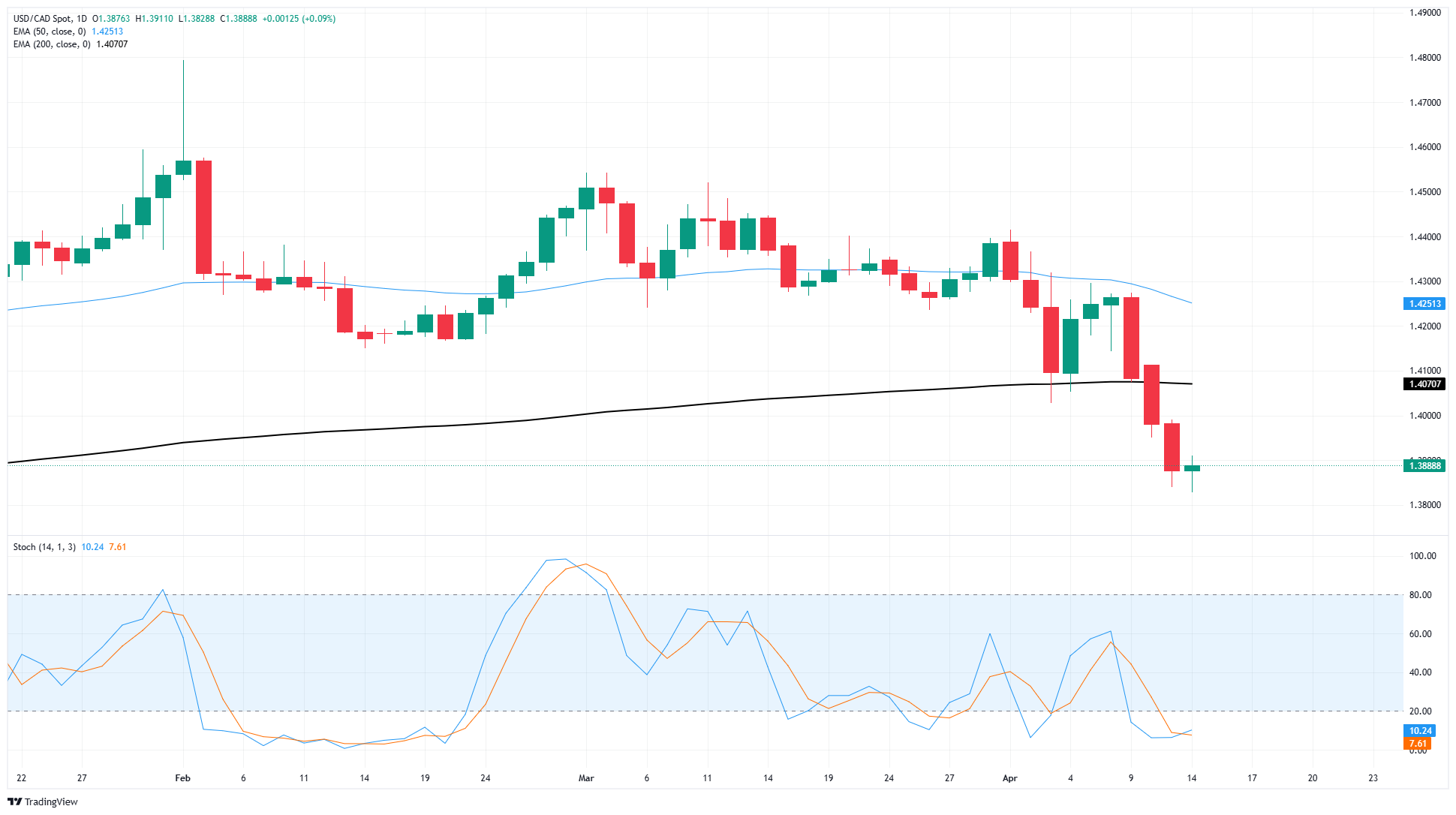- The Canadian Dollar appears to have finally run out of steam.
- Key Canadian CPI inflation figures will print this week, slated for Tuesday.
- Another BoC rate call also looms over Loonie markets, due on Wednesday.
The Canadian Dollar (CAD) appears to have run out of steam, snapping a three-day win streak and paring some of its newfound gains against the US Dollar (USD). Most of the Loonie’s near-term gains against the Greenback have come at the hands of a broad-market weakening in USD flows, rather than any particular strength to be found in the CAD itself.
The Bank of Canada (BoC) is poised to deliver another rate call this week, and markets are pondering whether the BoC will try to squeeze one more rate cut into the chute before tariffs begin to take bites out of the economy. Key Canadian Consumer Price Index (CPI) inflation, also due this week, will serve as a handy canary in the coalmine for what kind of moves on interest rates the BoC might be considering.
Daily digest market movers: Canadian Dollar ends bull run as BoC rate call looms
- The Canadian Dollar pared recent gains against the Greenback, pushing USD/CAD back to the 1.3900 level.
- Headline Canadian CPI inflation is expected to hold at 2.6% YoY on Tuesday.
- The BoC’s latest rate call is slated for Wednesday.
- The BoC is broadly expected to deliver 50 bps in rate cuts by the end of the year.
- Canadian markets will be cutting the week short for the Easter holiday on Friday.
Canadian Dollar price forecast
The Canadian Dollar took full advantage of a broad-base weakening in Greenback flows recently, rising 3.1% bottom-to-top against the US Dollar and pushing the USD/CAD pair to six-month lows below 1.3850. Momentum is freezing as markets pivot toward key data releases, leaving USD/CAD to churn on the low side of the 200-day Exponential Moving Average (EMA) near 1.4070.
USD/CAD daily chart

Canadian Dollar FAQs
The key factors driving the Canadian Dollar (CAD) are the level of interest rates set by the Bank of Canada (BoC), the price of Oil, Canada’s largest export, the health of its economy, inflation and the Trade Balance, which is the difference between the value of Canada’s exports versus its imports. Other factors include market sentiment – whether investors are taking on more risky assets (risk-on) or seeking safe-havens (risk-off) – with risk-on being CAD-positive. As its largest trading partner, the health of the US economy is also a key factor influencing the Canadian Dollar.
The Bank of Canada (BoC) has a significant influence on the Canadian Dollar by setting the level of interest rates that banks can lend to one another. This influences the level of interest rates for everyone. The main goal of the BoC is to maintain inflation at 1-3% by adjusting interest rates up or down. Relatively higher interest rates tend to be positive for the CAD. The Bank of Canada can also use quantitative easing and tightening to influence credit conditions, with the former CAD-negative and the latter CAD-positive.
The price of Oil is a key factor impacting the value of the Canadian Dollar. Petroleum is Canada’s biggest export, so Oil price tends to have an immediate impact on the CAD value. Generally, if Oil price rises CAD also goes up, as aggregate demand for the currency increases. The opposite is the case if the price of Oil falls. Higher Oil prices also tend to result in a greater likelihood of a positive Trade Balance, which is also supportive of the CAD.
While inflation had always traditionally been thought of as a negative factor for a currency since it lowers the value of money, the opposite has actually been the case in modern times with the relaxation of cross-border capital controls. Higher inflation tends to lead central banks to put up interest rates which attracts more capital inflows from global investors seeking a lucrative place to keep their money. This increases demand for the local currency, which in Canada’s case is the Canadian Dollar.
Macroeconomic data releases gauge the health of the economy and can have an impact on the Canadian Dollar. Indicators such as GDP, Manufacturing and Services PMIs, employment, and consumer sentiment surveys can all influence the direction of the CAD. A strong economy is good for the Canadian Dollar. Not only does it attract more foreign investment but it may encourage the Bank of Canada to put up interest rates, leading to a stronger currency. If economic data is weak, however, the CAD is likely to fall.
Information on these pages contains forward-looking statements that involve risks and uncertainties. Markets and instruments profiled on this page are for informational purposes only and should not in any way come across as a recommendation to buy or sell in these assets. You should do your own thorough research before making any investment decisions. FXStreet does not in any way guarantee that this information is free from mistakes, errors, or material misstatements. It also does not guarantee that this information is of a timely nature. Investing in Open Markets involves a great deal of risk, including the loss of all or a portion of your investment, as well as emotional distress. All risks, losses and costs associated with investing, including total loss of principal, are your responsibility. The views and opinions expressed in this article are those of the authors and do not necessarily reflect the official policy or position of FXStreet nor its advertisers. The author will not be held responsible for information that is found at the end of links posted on this page.
If not otherwise explicitly mentioned in the body of the article, at the time of writing, the author has no position in any stock mentioned in this article and no business relationship with any company mentioned. The author has not received compensation for writing this article, other than from FXStreet.
FXStreet and the author do not provide personalized recommendations. The author makes no representations as to the accuracy, completeness, or suitability of this information. FXStreet and the author will not be liable for any errors, omissions or any losses, injuries or damages arising from this information and its display or use. Errors and omissions excepted.
The author and FXStreet are not registered investment advisors and nothing in this article is intended to be investment advice.
Recommended content
Editors’ Picks

EUR/USD holds steady above 1.1400 ahead of key US data
EUR/USD struggles to gather recovery momentum but holds steady above 1.1400 on Wednesday following the mixed PMI data releases for the Eurozone and Germany. Markets await comments from central bankers and US PMI data.

GBP/USD stays weak near 1.3300 after disappointing UK data
GBP/USD stays under bearish pressure near 1.3300 on Wednesday. Pound Sterling is having a tough time attracting buyers following the weaker-than-forecast April PMI data from the UK. BoE Governor Bailey will speak later in the day and the US economic calendar will feature PMI reports.

Gold stabilizes above $3,000 after sharp decline on Trump's softer tone on trade and Fed
Gold stabilizes above $3,300 after correcting sharply from the all-time high it set et $3,500 early Tuesday. US President Donald Trump's softer tone on Fed Chairman Jerome Powell's position and trade relations with China seems to be discouraging buyers.

US S&P Global PMIs set to highlight worsening services and manufacturing sectors in April
Investors are bracing for a modest pullback in April’s flash Manufacturing PMI, expected to slip from 50.2 to 49.4, while the Services PMI is forecast to ease from 54.4 to 52.8.

Five fundamentals for the week: Traders confront the trade war, important surveys, key Fed speech Premium
Will the US strike a trade deal with Japan? That would be positive progress. However, recent developments are not that positive, and there's only one certainty: headlines will dominate markets. Fresh US economic data is also of interest.

The Best brokers to trade EUR/USD
SPONSORED Discover the top brokers for trading EUR/USD in 2025. Our list features brokers with competitive spreads, fast execution, and powerful platforms. Whether you're a beginner or an expert, find the right partner to navigate the dynamic Forex market.



